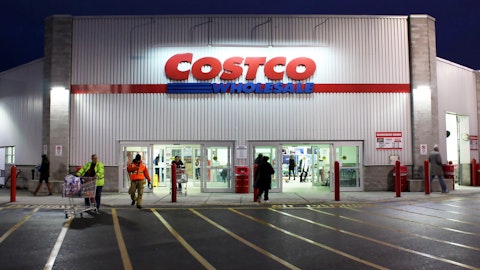As online retailers are challenging traditional brick-and-mortar stores in terms of pricing, there’s one category in which traditional retailers are capable of standing up to them and attracting customers with lower prices: warehouse stores. Americans like lower prices (who doesn’t?), which became particularly vital following the recent financial crisis, when a decline in disposable income forced many households to start looking for cheaper prices. IBISWorld estimates the total revenue of warehouse clubs at supercenters at $460 billion, but pointed out that a fast development over the last decade helped the industry become saturated. However, even though a slowdown is expected, the industry is expected to increase its share of the retail sector through 2021.
Warehouse stores have a lower markup than supermarkets, which allows them to compete with low-overhead retailers. Currently, there are three popular warehouse stores: Costco Wholesale Corporation (NASDAQ:COST), Sam’s Club (owned by Wal-Mart Stores Inc (NYSE:WMT)) and BJ’s Wholesale Club. For example, Amazon.com, Inc. (NASDAQ:AMZN)’s average markup is estimated at around 15%, Costco has a markup of 10%, while mainstream supermarket chain Target’s markup amounts to around 46%. Even though warehouse clubs require customers to purchase a membership, the price of which depends on the benefits offered, customers can make up for these costs by buying goods in bulk at lower prices. Warehouse clubs also have other benefits that allow them to compete with online retailers, such as offering a wide range of products, from tires and car batteries, to jewelry and flat screen TVs, branding themselves as places for “one stop shopping”. Most club stores also have specialty businesses like optical shops, pharmacies, and gas stations.
However, even though warehouse club retailers make the largest part of their money through membership fees, customers don’t always save money even though the goods are bought at lower prices. Customers are inclined to make up the costs for the entry fee, which leads to them buying more stuff with the idea that they are saving more money. Nevertheless, according to a survey conducted by Consumers’ Checkbook in 2012 and cited by CNBC, a household that spends $150 per week at a mainstream supermarket, can save over $2,000 per year when shopping at one of the three aforementioned warehouse stores.

Copyright: nicoletaionescu / 123RF Stock Photo
On the other hand, warehouse clubs also have their drawbacks, the main one being the small selection, despite a wide range of product categories. According to CNBC, Costco has around 4,000 items, while BJ’s and Sam’s Club have approximately 7,200 and 4,900 items, respectively. While these numbers may not seem small, they pale in comparison to the 100,000 items carried by a traditional Wal-Mart supermarket. In this way, customers that shop at a warehouse store are also required to go to a grocery store to fill out their groceries list.
Nevertheless, warehouse clubs’ customers are not being scared away by fewer options and having to pay a membership fee. With the three aforementioned warehouse clubs: Sam’s Club, Costco, and BJ’s Wholesale club dominating the market, we decided to take a look at how they stack up against each other.
Let’s start with Sam’s Club, the largest chain of warehouse club stores. Sam’s Club, which is owned by Wal-Mart Stores Inc (NYSE:WMT), has around 655 stores across the US with an average size of 134,000 square feet. Sam’s Club also operates an online portal at samsclub.com, while physical stores are available in 48 states in the U.S. as well as in Puerto Rico. According to the company’s last 10-K report with the US Securities and Exchange Commission, for its fiscal 2016, Wal-Mart’s Sam’s Club segment had sales of $56.8 billion, representing roughly 12% of the company’s net sales. However, since Sam’s Club is a warehouse club, it has lower operating expenses than Wal-Mart Stores Inc (NYSE:WMT)’s other segments and a lower gross profit rate as percentage of sales.

Richard Bradford/Shutterstock.com
Aside from having the highest number of stores, Sam’s Club also has the lowest membership fee. The basic Savings and Business memberships cost $45 per year, while Savings Plus and Business Plus cost $100, but offer cash rewards, which include $10 for every $500 worth of qualifying purchases (up to $500 per year).
Costco Wholesale Corporation (NASDAQ:COST)‘s chain is the second-largest in terms of the number of U.S. stores. The company operates 501 stores in the US as of the end of August 2016, and also has international exposure, with 715 warehouses worldwide. The company had 36.80 million Gold Star members (for individuals) and a total of 47.60 million members last year and registered a renewal rate of 90% in the U.S. and Canada and 88% worldwide. Costco Wholesale Corporation (NASDAQ:COST)’s membership fee of $55 is the highest among the three warehouse clubs covered in this article. Costco also offers Executive Membership at $110 per year, which provides a 2% reward on qualified buys.

Niloo / Shutterstock.com
The company had net sales of $116.07 million in its fiscal 2016 (ended August 28) and membership fee income of $2.65 million. Costco’s strategy is to provide a wide range of products and to limit specific items in each product line to the most popular sizes, colors, and models. This allows the company to keep lower gross margins, which amounted to 11.35% as percentage of net sales in fiscal 2016, and is probably the lowest among the three.
For BJ’s Wholesale Club, only limited data is available due to the company having been acquired and taken private by Beacon Holding Inc. in 2011. The company is the smallest in terms of the number of stores, having just 210 clubs in only 15 states. The membership cost at BJ’s is $50 per year, the second-cheapest after Sam’s Club. At $100 per year, BJ’s customers can get a Perks Rewards membership, entitling them to 2% cashback on most in-store and online purchases.

Trong Nguyen/Shutterstock.com
Conclusion: There are many surveys sampling consumers’ preferences towards different warehouse stores. In terms of raw data, Costco and Sam’s Club stand out, as they have more stores and more members than BJ’s Wholesale Club. All three chains offer online shopping and tools to improve the shopping experience at physical stores. A Consumer Reports survey in 2012, found that Costco’s customers had the highest rate of satisfaction among the customers of nine other big retail chains. In 2015, Consumer Reports also said that Costco’s in-house brand Kirkland offers products at the same or better quality than similar products from more expensive names. So Costco may be the best warehouse store, but, in any case, if you have a car and are looking for good deals, acquiring a membership at a warehouse club is definitely worth it.
Disclosure: None





